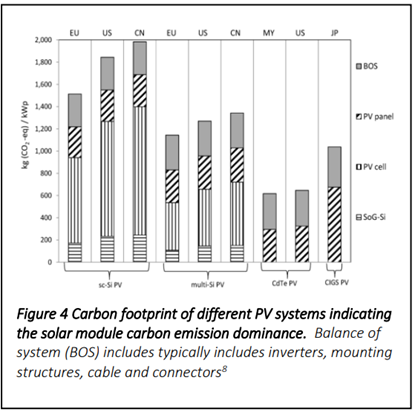The future is solar powered
A ten-fold increase in the current pace of new solar construction is required to decarbonize the U.S. power grid by 2050, according to the U.S. Department of Energy’s Solar Futures Study released last year. Per the study, roughly 30 gigawatts (GW) of new solar must be built each year between now and 2025, increasing to 60GW annually between 2025-2030, until ultimately reaching nearly 1000GW of new solar installed by 2035.
Building new power at this scale, this quickly, requires action across the entire renewable power industry to avoid unnecessary and unintentional harm to the environment and communities. By generating carbon-free power, solar helps our planet transition to a more sustainable future. Across its lifecycle, solar has less than 10 percent of the carbon footprint of fossil power, even fossil power with carbon capture and storage. However, building any new infrastructure comes with environmental impacts to consider.
Building responsibly
Bechtel is working with the solar industry to responsibly build the clean energy future, creating access and opportunities for communities across the globe. As an EPC provider and project developer, we are exploring how decisions made across the solar value chain influence the environmental impact of our projects. We are considering the environmental and financial impacts of various design decisions at different stages of the project lifecycle, from site identification to technology selection and construction.
Land
Depending on the site and technology used, one megawatt of utility-scale solar requires roughly 4-6 acres of land. At the U.S. DOE’s forecasted required rate of deployment, that would mean converting 120,000 – 180,000 acres of land to solar farms each year between now and 2025, approximately the area covered by 100,000 football fields.
As part of their More than a Megawatt initiative, Salesforce worked with The Nature Conservancy to develop guidelines for building responsibly and minimizing land-use impacts, for example, by avoiding uncleared land with high habitat value. While these guidelines were created for clean energy buyers to use in purchasing decisions, developers can also apply them when siting and designing projects. Proactively minimizing environmental impacts on land can also speed the permitting timeline, helping developers deploy more renewable power faster.
Vegetation management practices can also impact a project’s carbon footprint. Vegetation clearing and soil disturbance can release carbon. On the other hand, carefully managing vegetation with regenerative practices, or choosing vegetation with deep roots, can sequester additional carbon in the soil where solar is built. Following pollinator-friendly solar practices can also help improve wildlife habitat (and potentially even crop yields).
Modules
Anything built today will have some level of embodied carbon, or emissions associated with the raw material extraction, manufacture, transport, and construction of new infrastructure. According to the Global Electronics Council, at least half (but often the majority) of embodied carbon in solar facilities comes from modules.

The Ultra Low Carbon Solar Alliance is an industry group dedicated to improving awareness and deployment of ultra-low-carbon PV to minimize emissions associated with the solar supply chain. The group estimates that developers could reduce the upfront carbon emissions for solar facilities by 50 percent just by choosing panels with lower embodied carbon.
France and Korea already have standards to promote low-carbon modules in new solar facilities. However, in markets without regulations, the solar industry may be slower to move. Many suppliers have already booked their module capacity through the end of this year and into next to meet growing demand. Without a coordinated effort from buyers and owners demanding low-carbon solar products in their RFPs, there is no signal or incentive for module suppliers to meet low-carbon standards. Asking for Environmental Product Declarations for modules and other major equipment is a good place to start.
Balance of system and construction
In addition to modules, most utility-scale solar facilities also have piles, trackers, inverters, cabling, and transformers installed on site. Suppliers in this space tend to be at an earlier stage of their efforts to decarbonize. For example, low-carbon steel options are increasingly available on the market, but work still needs to be done to connect these suppliers with tracker manufacturers. Bechtel has deep supply chain expertise with a global reach that can help us engage with suppliers to reduce emissions.
When it comes to construction itself, some swaps can be made using products available on the market today. For example, hybrid excavators and electric / hybrid trucks can replace diesel-powered equipment for a significant share of the groundwork on site. On our solar job sites, we are using closed-loop water recycling systems to reduce truck mileage for deliveries and improve the comfort, health, and safety for our craft professionals. The systems can also provide drinking water to alleviate the need for single-use plastic water bottles on site.
End of life and circularity
Solar manufacturers are beginning to think beyond upfront carbon and consider circularity of materials in their manufacturing approach. One module supplier boasts a 90 percent recovery rate for materials used in their modules when solar facilities reach their end of life. Maximizing material recovery for modules and other equipment as part of the decommissioning planning for new facilities will be paramount to minimizing the environmental impact of renewables.
Collaboration is key
Our Bechtel Enterprises development team is working with our engineering and procurement teams to integrate some of the principles described above into our solar development approach, using our own projects as a laboratory for new customer offerings. We are also speaking with leaders from across the industry, including major equipment providers and leaders from Clean Energy Buyers Institute’s Decarbonizing Industrial Supply Chain Energy (DISC-e) program, to learn more about environmental concerns related to solar development and working together to address them.
Continue the conversation
Interested in learning more or joining us on our journey? Get in touch!
Clean Energy Buyers Institute DISC-e Program [email protected]
Julie Ufford Keenahan, Clean Energy Development Manager, Bechtel Enterprises
Frank McAlpin, Contracts and Procurement Manager, Core Renewables
Catherine McKalip-Thompson, Global Sustainable Development Manager, Bechtel Infrastructure



